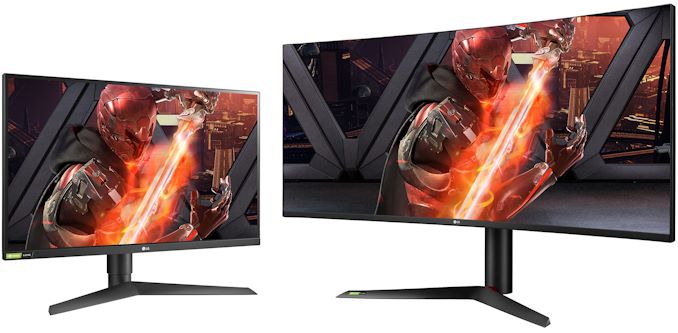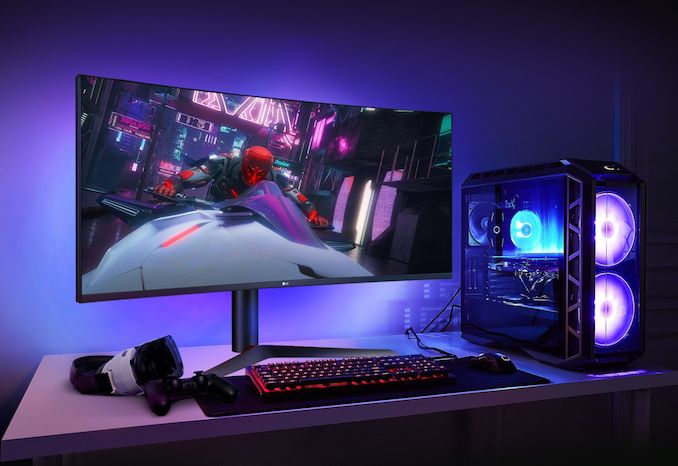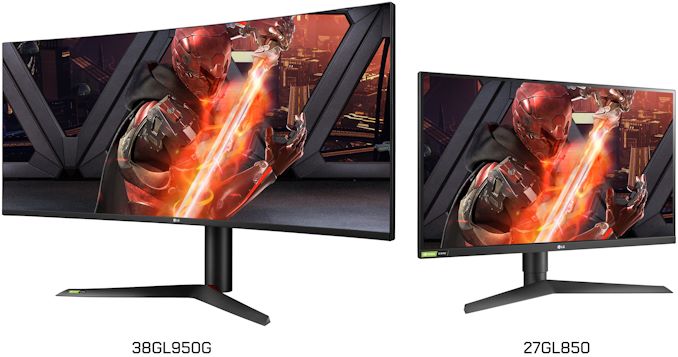LG Unveils 27 and 37.5-Inch IPS Monitors with 1 ms Response Time
by Anton Shilov on June 13, 2019 5:00 PM EST
LG has introduced the industry’s first IPS displays featuring a 1 ms response time. The new UltraGear monitors bring together high image quality that LG’s Nano IPS panels are known for, the DCI-P3 color gamut, high performance, and NVIDIA G-Sync support. Aimed primarily at gamers, the new UltraGear monitors will come in 27-inch and 37.5-inch sizes.
The smaller monitor is the LG UltraGear 27GL850 that uses a 27-inch IPS panel featuring a 2560×1440 (16:9) resolution, 350 nits brightness, a 144 Hz refresh rate, and 1 ms GtG response time. The larger display is the UltraGear 38GL950G based on a 37.5-inch panel offering a wider aspect ratio 3840×1600 (21.5:9) resolution, 450 nits brightness, a 175 Hz refresh rate (when overclocked), and also a 1 ms response time. The smaller monitor supports HDR10, whereas the bigger one is DisplayHDR 400 certified.
Both UltraGear 27GL850 and UltraGear 38GL950G LCDs can display 1.07 billion colors and cover 98% of the DCI-P3 color gamut, a very good result for gaming-grade monitors. The two displays also feature LG’s Nano IPS panels featuring a special nanoparticle cover applied to the screen’s LED backlighting to fine-tune its spectral output to absorb surplus light wavelengths and increase intensity, purity, as well as the accuracy of the on-screen colors.
Since LG’s UltraGear displays are designed primarily for gamers, both support a number of features aimed at this audience. Apart from NVIDIA’s G-Sync dynamic refresh rate technology, the new LCDs also support LG’s Dynamic Action Sync mode, Black Stabilizer, and Crosshair functions. Besides, the larger display supports LG’s Sphere Lighting 2.0 technology.
As far as connectivity is concerned, both LG’s UltraGear 27GL850 and UltraGear 38GL950G monitors feature DisplayPort and HDMI inputs, as well as a dual-port USB 3.0 hub. Meanwhile, they have neither a headphone jack nor integrated speakers.
| The LG UltraGear-Series Displays | |||
| 27GL850 | 38GL950G | ||
| Panel | 27" IPS | 37.5" IPS | |
| Native Resolution | 2560 × 1440 (16:9) |
3840 × 1600 (21.5:9) |
|
| Refresh Rate | 144 Hz | Native: ? Hz Overclocked: 175 Hz |
|
| Dynamic Refresh Rate | Technology | NVIDIA G-Sync compatible | NVIDIA G-Sync |
| Range | ? | ? | |
| Response Time | 1 ms (gray-to-gray) | ||
| Brightness | 350 cd/m² | 450 cd/m² | |
| Contrast | ? | ||
| Color Gamut | 125% sRGB 98% DCI-P3 |
||
| Viewing Angles | 178°/178° horizontal/vertical (?) | ||
| Curvature | none | curved | |
| Inputs | 1 × DisplayPort 1.2 2 × HDMI 2.0 |
1 × DisplayPort 1.2 1 × HDMI 2.0 |
|
| USB Hub | 2 × USB 3.0 Type-A | 2 × USB 3.0 Type-A | |
| Audio | none | ||
| Proprietary Enhancements | Dynamic Action Sync mode, Black Stabilizer, Crosshair |
||
| Stand | Height | ? | |
| Tilt | ? | ? | |
| Swivel | ? | ? | |
| Power Consumption | Idle | ? | |
| Typical | ? | ||
| Maximum | ? | ||
LG plans to start sales of the UltraGear 27GL850 display in the third quarter with pre-orders in the US starting on July 1, 2019. LG does not disclose pricing of either UltraGear 27GL850 or UltraGear 38GL950G monitors, but without any doubts both will belong to the company’s premium family of products.
Related Reading:
- LG Unveils UltraGear 34GK950 34-Inch Curved Gaming Displays with Nano-IPS
- LG to Demo UltraWide 38-Inch 144Hz Gaming & 49-Inch Workstation Displays at CES
- LG Launches Midrange 32UL750-W Monitor: DisplayHDR 600 with FreeSync & USB-C For $750
Source: LG












49 Comments
View All Comments
Beaver M. - Saturday, June 15, 2019 - link
Adaptive overdrive, better response times, lower input lag is stuff thats worth a lot.Dragonstongue - Friday, June 14, 2019 - link
nice specs butGsync only?
seriously LG
grrrrrrrrr
knorr555 - Friday, June 14, 2019 - link
i just ordered 2 x LG 24gk950f and both of the had terrible backlight bleed (the second one came in even worse), so watching movies in the dark room did not feel premium at all, considering the price tag. Now, they are adding ambient lighting to lessen the perceived backlight bleed instead of increasing the quality standards?knorr555 - Friday, June 14, 2019 - link
and i mean backlight bleed, in addition to the extreme ips glow at certain angles from above the center lines of the monitors. Somehow, it feels like LG is pushing to deliver first, but not the best they could.Beaver M. - Friday, June 14, 2019 - link
That surprises you still?Same thing with any other panel manufacturer.
They dont do it like GPU, CPU manufacturers, where bad ones will simply be made into a cheaper product or not used at all.
No, they obviously have so many bad ones because of their horrible manufacturing process, that they have to sell even the blatantly broken ones at full price as a super high end one at 10 times (no exaggeration) the production value.
But as long as people keep buying it in droves and even defend shit like this, they will keep doing it.
knorr555 - Monday, June 17, 2019 - link
at first, I was a bit surprised (yet prepared by some reviews), because I had 34uc98w for years and I loved every bit of it (plus another great 60hz 27 incher before that from LG). But when the clock strikes midnight, the magical creatures come out, some of them glow but some bleed underneath the glow.In either, the refund is pending.
Beaver M. - Wednesday, June 19, 2019 - link
I still have an IPS monitor with LG panel from 2012. Its perfect. No BLB, no dead pixels, pretty fast, no input lag (as in lower than 1 ms). Its just so old that its starting to develop clouding and only has 75 Hz.I wanted something like that again, just bigger, with GSync, high refreshrate.
No chance. They all devolved into crap.
planedrop - Friday, June 14, 2019 - link
Pretty sure the spec that says DP 1.2 is wrong. You cannot do HDR over DP 1.2. So if that was the case, your choices would either be GSync over DP, or HDR with HDMI, but not both GSync and HDR which IMO makes this a lot less worth it.Skeptical123 - Tuesday, June 18, 2019 - link
It depends on the type of HDR. DP1.2 can defiantly support HDR. It help on the low level to think of DP as a pipe with a capacity of the speed of the spec version. A high bitrate HDR 1080p stream will use similar capacity to a non HDR 4k stream for example.planedrop - Monday, June 24, 2019 - link
Yes but Windows also won't even let you enable HDR on a DP1.2 monitor, or at least 1903 won't. I have an Acer 38 inch XR382CQK with HDR support (it's HDR perf isn't great, but it's still better looking than without), but if I turned HDR on when DP1.2 was connected, the display would go entirely black and never recover (and yes I checked all the obvious things like making sure HDR was enabled for DP on the display etc...). Once I used HDMI 2.0 it worked just fine.And too add to that, this is the only place DP1.2 is listed, every other source including the press release don't mention it, so I am guessing it was a mistake and DP1.4 will be used.